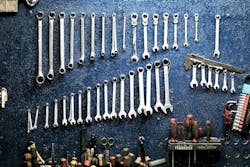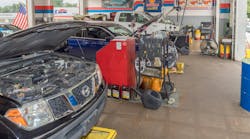This has been an unusually harsh winter across most of the country. Snow, ice, cinders and road salt have all combined to form a toxic environment for brake system components. All of these contaminants will likely have collected on vital brake system parts like disc brake pads, rotors, calipers and parking brake mechanisms. Rust and corrosion can form quickly in this harsh, cold, moist environment. And such rust can compromise brake system operation.
Certainly, anything that reduces braking effectiveness is a safety hazard and can lead to loss of control and collisions. But there's an even more insidious situation that can develop in these conditions. Most newer cars, trucks and SUVs today are equipped with some combination of anti-lock braking (ABS) systems and vehicle stability control (VSC) systems. These sophisticated systems typically receive input signals from toothed reluctor teeth and sensing magnets at each wheel. Then, the control module compares all of these signals, determines whether one or more wheels are slipping and selectively applies braking power to other wheels until full traction is achieved.
If any of the reluctor teeth are broken or obstructed with ferrous debris, the system will not function properly, and braking power will be diminished.
For all of these reasons and more, brake system service after winter weather is vital. Such service should include a careful visual inspection of calipers, pads, rotors, hoses and hardware. If significant rust is present, use a good lubricant/penetrant product to cut the rust and lubricate moving parts.
If road salt or other contaminants are present on the rotor or pad friction surfaces, use a dedicated brake parts cleaner. This will remove debris without leaving a residue that could compromise braking effectiveness.
Depending on your locale, you may want to choose your brake parts cleaner accordingly. Such cleaners are offered in chlorinated or non-chlorinated formulations, low and ultra-low VOC compounds and also in quick-dry blends.
An often-overlooked service is periodic flushing and replacement of brake fluid. Some automakers recommend flushing and fluid replacement as often as every 2-3 years. It is a service that motorists are often not aware of and that technicians often fail to recommend.
In fact, such flushing and fluid replenishment are services ideally suited to the quick lube environment. With a power bleeder, the service can be performed quickly and profitably. And it can easily lead to additional needed services, like replacement of brake pads and rotors or replacement of stuck or leaking brake calipers. Few motorists will argue with a recommendation for brake system repairs, as they are not willing to put themselves and their families at risk.
You have good, viable choices when it comes to choosing brake fluid. Most cars on the road today are factory-filled with non-silicone DOT 3 or DOT 4 brake fluid. Some high-end sports cars may be factory-filled with silicone fluid, which is designated as DOT 5. But these applications are rare.
Note, by the way, that all brake fluid is synthetic. This often causes confusion because "synthetic" is often mistaken for "silicone" and vice versa.
Since all DOT 3 and 4 fluids are fully compatible, you can choose to simply match whatever was OE in the vehicle you're servicing. However, if you know that a vehicle is used for towing or other severe service, you can upgrade a DOT 3 system to DOT 4 fluid which, while fully compatible, offers a higher boiling point than DOT 3. There are some premium DOT 4 brake fluids that provide an even higher boiling point for a greater margin of safety.
Another compelling reason for a brake fluid flush and fill is the fact that DOT 3 and 4 brake fluids are hygroscopic, which means they tend to absorb moisture from the atmosphere and elsewhere. Such moisture can collect in brake lines, causing rust-through and possible brake failure. This water can also freeze in frigid temperatures, further compromising the performance of braking systems, anti-skid systems and other vehicle stability control mechanisms.
This is also a prime opportunity to evaluate the condition and performance of the parking brake mechanism. Such mechanisms are exposed to the elements. Worse yet, with most vehicles on the road equipped with automatic transmissions, many drivers shift into Park and opt not to apply the parking brake. Prolonged inaction can cause rust and corrosion to develop on cables, levers and elsewhere within the parking brake system. Careful inspection and proper cleaning and lubrication are the order of the day, along with a friendly reminder to your customers to use their parking brake regularly.
Certainly, hostile winter weather can present the opportunity to provide additional value-added services, particularly in the quick lube environment. Even toward the end of the season, products like fuel injector cleaner, windshield de-icer, various engine rejuvenation chemicals, mass air flow (MAF) sensor cleaners and others can optimize engine performance and driving safety in challenging driving conditions.
One more thing to consider is the likelihood that snow and moisture, contaminated with road salt and cinders, could have been drawn into differentials through breather vents as vehicles drive through snow and slush. This water and debris can damage internal differential/axle components. Quick lube shops are well-positioned to provide flush and fill services for front and rear differentials using dedicated cleaning products.





